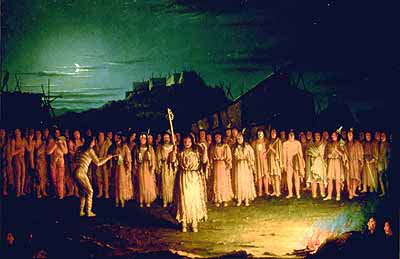http://www.indigenouspeople.net/Paseeda/Slideshow/

Native Words, Native Warriors
The National Museum of the American Indian honors American Indian Code Talkers. This is a companion website to the traveling Smithsonian Institution exhibition, Native Words, Native Warriors.

Most American Indians were not legally considered citizens of the United States until 1924. Even then, some states refused to let American Indians vote until as late as the 1950s.
Despite this tragic history, many American Indian men and women have served in all branches of the military. In many conflicts and wars, including World War I and World War II, American Indians honorably defended their homelands and the United States.

During World War I and World War II, hundreds of American Indians joined the United States armed forces and used words from their traditional tribal languages as weapons. The United States military asked them to develop secret battle communications based on their languages—and America’s enemies never deciphered the coded messages they sent. “Code Talkers,” as they came to be known after World War II, are twentieth-century American Indian warriors and heroes who significantly aided the victories of the United States and its allies.
For thousands of years, American Indian men have protected their communities and lands. “Warrior” is an English word that has come to describe them. However, their traditional roles involved more than fighting enemies. They cared for people and helped in many ways, in any time of difficulty. They would do anything to help their people survive, including laying down their own lives.

Warriors were regarded with the utmost respect in their communities. Boys trained from an early age to develop the spiritual, mental, emotional, and physical strength they would need to become warriors. Many tribes had special warrior societies, which had their own ceremonies, songs, dances, and regalia that they wore. Usually, a warrior had to prove himself before being asked to join a warrior society. It was a great honor to be chosen in this way.

| Native American Women – Women Warriors The word ‘warrior’ sends a tingle of fear down the spine. The word conjures up fierce, merciless fighters seemingly invulnerable to fear or intimidation and prepared to fight to the death using deadly weapons and blood thirsty tactics to achieve victory. Not the usual image that we would associate with women – but there were many Native American Women Warriors. Whilst the warrior class in tribal societies was typically all-male, there were exceptions where young, unmarried women formed part of the warrior class – the Warrior Women. |

The Dog Soldiers or Dog Men (Cheyenne: Hotamétaneo’o) are historically one of six Cheyenne military societies. Beginning in the late 1830s, this society evolved into a separate, militaristic band that played a dominant role in Cheyenne resistance to the westward expansion of the United States in the area of present-day Kansas, Nebraska, Colorado, and Wyoming, where the Cheyenne had settled in the early nineteenth century.
After nearly half the Southern Cheyenne died in the cholera epidemic of 1849, many of the remaining Masikota band joined the Dog Soldiers. It effectively became a separate band, occupying territory between the Northern and Southern Cheyenne. Its members often opposed policies of peace chiefs such as Black Kettle. In 1869 United States Army forces killed most of the band in the Battle of Summit Springs in Colorado Territory. The surviving Cheyenne societies became much smaller and more secretive in their operations.
The twenty-first century has seen a revival of the Dog Soldiers society in such areas as the Northern Cheyenne Indian Reservation in Montana and among the Cheyenne and Arapaho Tribes in Oklahoma.

